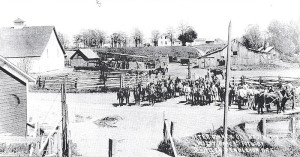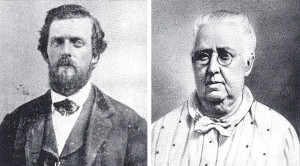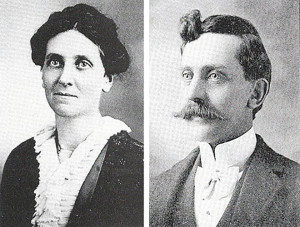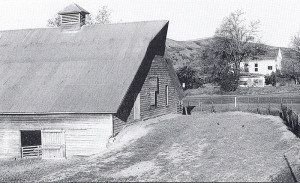Welcome to the Halfway House on the Mullan Road History Website
The Mullan Road
The first engineered wagon road in the Northwest ran from Walla Walla, Washington to Fort Benton, Montana, connecting the Columbia and Missouri rivers.
The road was constructed by Lt. John Mullan and a crew of 100 civilians and 100 soldiers beginning in Walla Walla in June, 1859. After reaching Fort Benton by August, 1860, on their return the crew made repairs to the road and arrived back in Walla Walla in early October.
In May, 1861, Lt. Mullan began rebuilding and improving portions of the route. In August 1862, the 655 mile road, including the previously existing portion from Wallula to Walla Walla, was finally completed, providing a route for pioneer families, miners, and military supplies between two of the country’s major rivers. The completion of the road realized the long-held dream of President Thomas Jefferson of linking the continent from east to west.
Halfway House at Prescott
Beginning in 1869, Benjamin and Malinda Flathers provided a forage station and accommodations for travelers along the Mullan Road near Prescott. The Flathers’ station near the Mullan Road’s Touchet River crossing was called Halfway House because of its location approximately halfway between the Fort in the town of Walla Walla and the road’s Snake River crossing at Lyons Ferry.
Ben Flathers operated a pack train along the California coast from 1854-61 before moving his operation to The Dalles, from which he packed to the Montana mines through Walla Walla. There he met Malinda Harris, whose husband and sons had died. In 1869 they were married, and then leased and purchased land along the Touchet River from Henry Hart Spaulding, the son of the missionary.
Here they established their Halfway House just south of the present intersection of Highway 124 and 125, and west of where the town of Prescott was to be established in 1882 as a railroad station on the Oregon Rail & Navigation Company (OR&N) line.
Flathers Descendants
Julia Flathers (1869-1960) was the eldest of six Flathers children all born in the Halfway House station operated by their parents for over two decades at the Touchet River crossing of the Mullan Road just west of present day Prescott.
Julia’s siblings were John Taylor Flathers (1870-1925), Emery Elias Flathers (1872-1949), Ivia E. Flathers (1873-1892), Baby Flathers (1875-1875), and Charles Franklin Flathers (1893-1974).
The Flathers children were all educated in a one-room school maintained by their father on their ranch along the Touchet.
Many Flathers descendants are stilling living in the area and throughout the Northwest.
The Significance of the Road
In 1866 a memorial to the U.S. Congress by the Montana territorial legislature in Helena pleaded for federal funding for repairs to the Mullan Road, and reminded Congress of “the necessity for a great national highway connecting the Missouri and Columbia rivers by a good and substantial wagon road.”
Though the figures used were perhaps an exaggeration, the memorial went on to say, “From Jan. 1 to Nov. 15, 1866, 1500 head of horses have been purchased by individual miners at Walla Walla; 5000 head of cattle were driven from Walla Walla to Montana; 6000 mules have left the Columbia river and Walla Walla loaded with freight for Montana; 52 light wagons with families have left Walla Walla for Montana; 31 wagons with immigrants have come through from the States via the Mullan Road, a portion of whom settled in Walla Walla valley… not less than 20,000 persons have passed over the Mullan road to and from Montana during the past season; $1,000,000 in treasure has passed down through Walla Walla and Wallula during the same period.”
The Touchet & Snake River Crossings
The Touchet River crossing was the first major bridge building by the Mullan party after leaving Walla Walla. In a report written a few days later from the Snake River crossing, John Mullan stated:
“Moving then on the 25th (of June, 1859) for the mouth of the Toukanon our work began. We crossed the dry creek repairing here a bridge and establishing a camp, marked it by a post buried three feet in the ground, and marked this ‘MR military road 9 miles.’
Moving still northward across the Touchet, improving and working the road from point to point we encamped upon its banks for two days and threw over it a strong substantial bridge built of the only timber at hand, viz, the cotton wood. This stream is difficult at high water But selecting a suitable spot, we constructed a bridge with three spans that is five feet above the high water mark.
Moving still northward we worked the road along the Reed creek, encamping at its head. Moving still northward with an advanced working party we improved and worked the road along the Toukanon to its mouth, crossing it three miles from its mouth.
The distance then from old Fort Walla Walla to this point is 78 miles and from the new fort 49 miles reaching this point on the 28th ultimo.
I have been much delayed and annoyed at this point in crossing the Snake river The river is frightfully swollen in consequence of the great freshet of this year, has been with the most extreme difficulty that we today effected crossing of our last load. The animals feared taking the water had to swim by being led across involving much time labor and risk; but today I am happy to state we completed the crossing, involving five days. We move at daybreak in the morning still northward…”
On his return journey, the Washington Territorial Legislature had granted Dan Lyons a franchise to operate a ferry on the Snake a few miles west of the Palouse, so Mullan moved his road there to take advantage of the Lyons Ferry crossing.
Walla Walla 2020 Historic Research & Plaque Project
Information on the Walla Walla 2020 Historic Research & Plaque Project is available here or by calling 509-522-0399.
Halfway House History Panel
Additional Resources
Photo Credits
Linda Flathers Parsley (1943-2002), eldest granddaughter of Emery & Rae Flathers, wrote Dancing With Mules (2001), from which facts and photos are included in this history website, site sign, and brochure.




